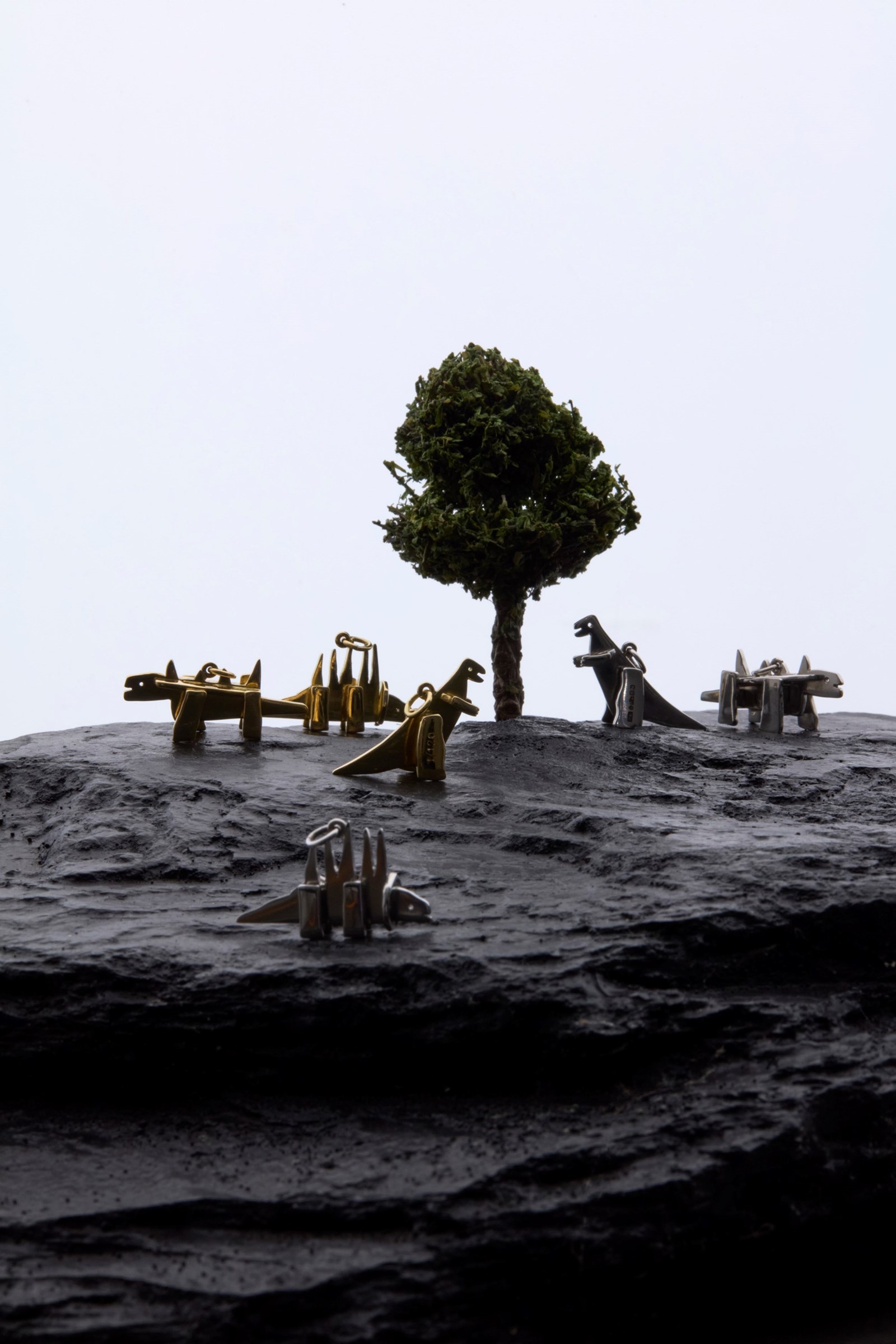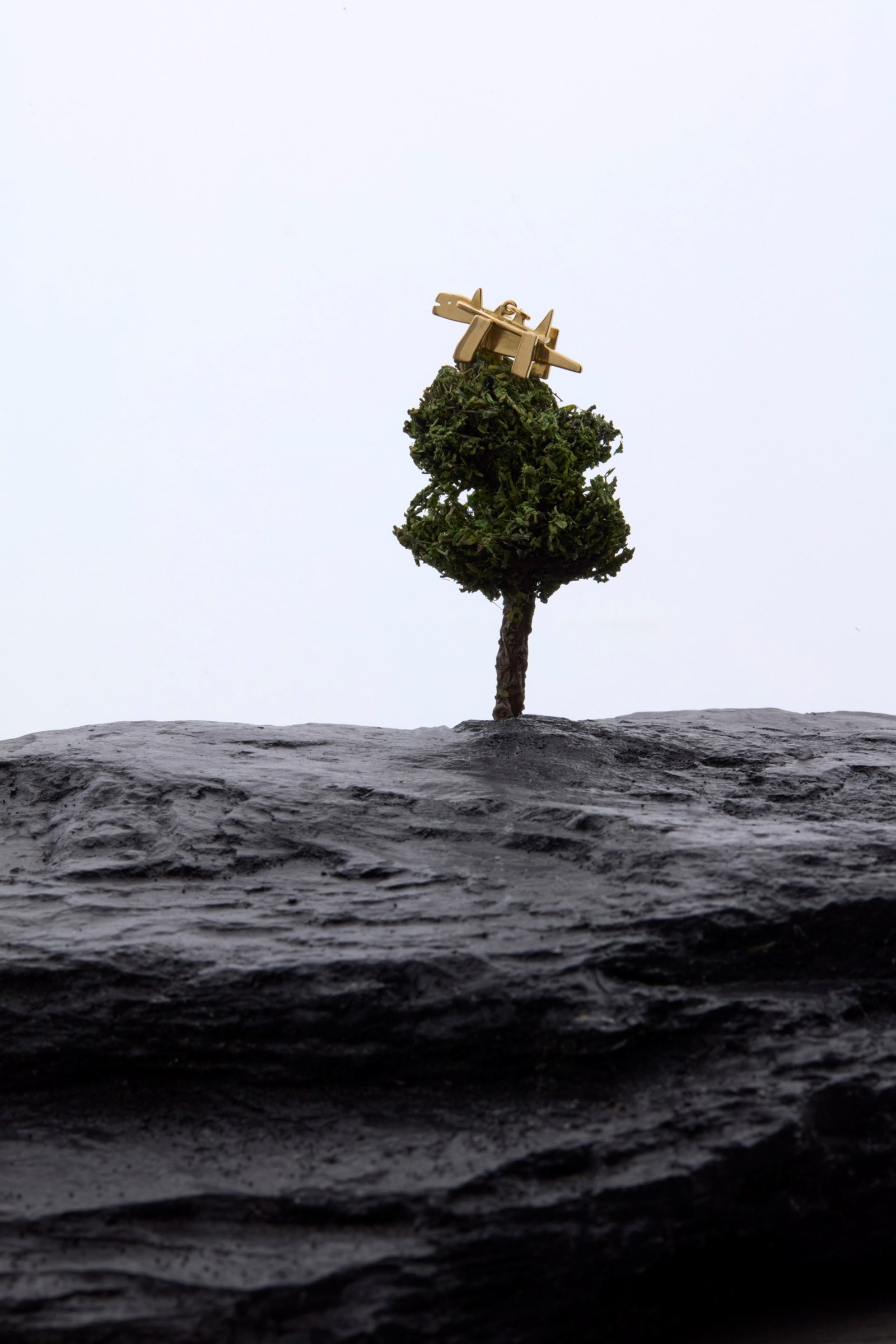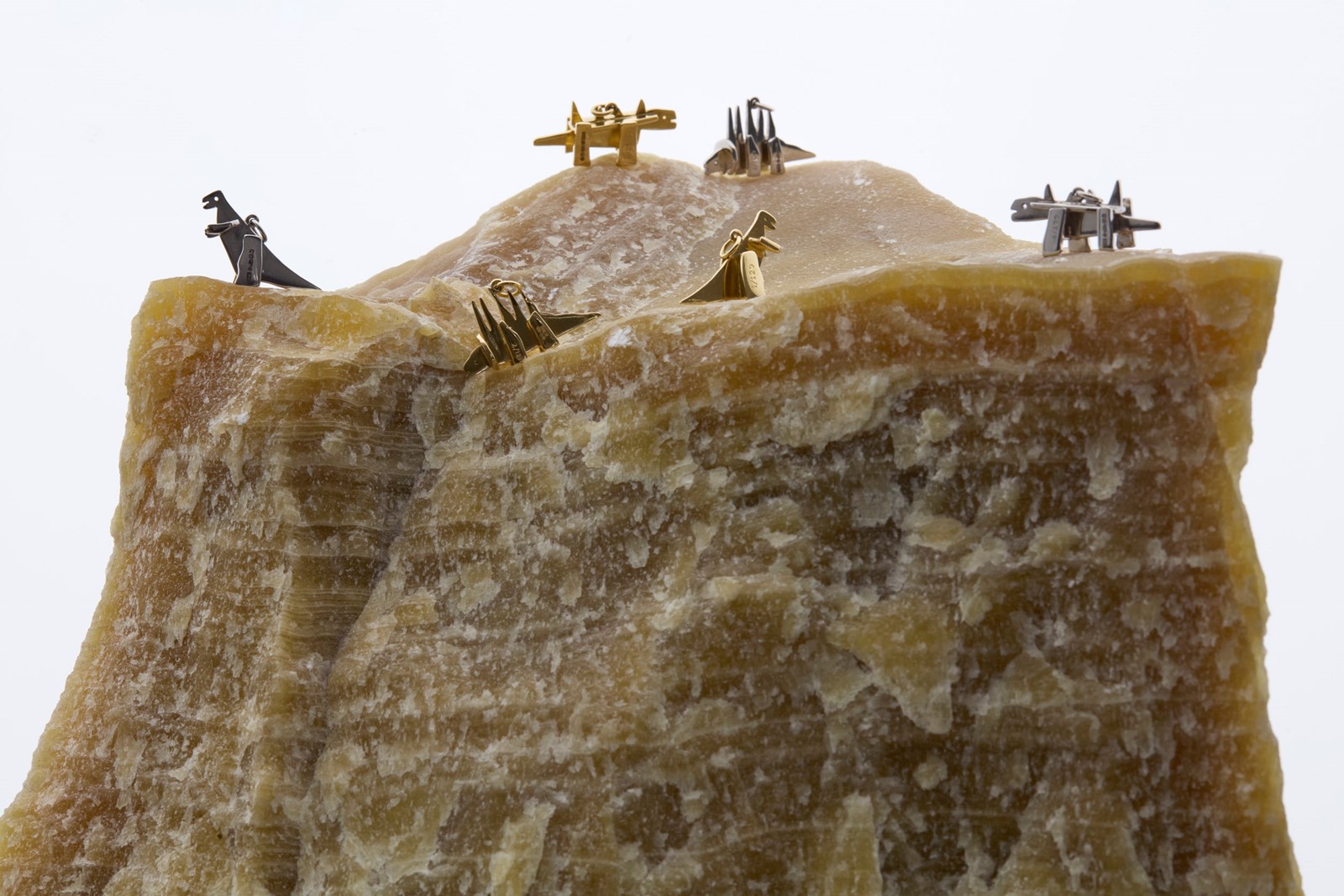“What are they fighting about?” asks Jake Chapman as he considers which of the flat-pack dinosaurs that inspire his new collaboration with jeweller and Cotswolds neighbour, William Welstead, would win in a fight. “Maybe it’s a road rage incident,” says Welstead. “But they’d probably be obliterated by the asteroid before they had a chance to get any beef going,” he continues, referring to a diamond-studded meteorite accompanying the gold and platinum prehistoric pendants in their collection, launching at Dover Street Market London in time for Frieze Art Fair.
Sat in the artist’s open-plan barn conversion, the unlikely couple – one half of the now defunct Chapman Brothers shock art duo, the other a rare gemstone whisperer – discuss the footpath once used for disposing of plague bodies where they now walk their dogs, the lights hanging above them that were salvaged from the toilets of a psychiatric hospital, and even an unsettling selfie on Chapman’s phone with former teen idol Donny Osmond. So far, so Chapmanesque.
Based on The Meek Shall Inherit the Earth, but not the Mineral Rights, The Good, The Bad and The Ugly, made up of three corten steel dinosaur sculptures by the Chapmans shown at the Royal Academy of Arts in 2007, Welstead’s miniatures capture the same crude, schoolroom art materials style. But Chapman quickly dispels any idea that his work is somehow childlike.
“Picasso said that thing about all children being artists,” he says. “Coming from a man who would wade into the sea at St Tropez up to his nipples then pretend to do front crawl with his arms because he couldn’t actually swim. What would someone that duplicitous know about innocence?”
Ahead of the entire collection being unveiled in a diorama, or Dinorama, created for DSM that, judging by the picture saved on Chapman’s phone, won’t disappoint fans of the PTSD-inducing vitrines that made up his infamous Hell, alongside an edit of custom stencilled tees, they talk about jewellery being a fetish, Darwinism and the horrors of bourgeois parenting, and the violent collision of worlds that underpins their collaboration. Like Welstead says, “The reason it’s interesting is because it’s odd.”

William Welstead: It’s a beautiful day in the countryside and we should be busy working but here we are prevaricating again.
Jake Chapman: Why haven’t you finished everything yet?
WW: Well, why haven’t you?
JC: You know, even though we only live a mile apart and share a dog walk I still wouldn’t say we’ve actually bonded over anything.
WW: It was more a meeting of ley lines that brought us together.
JC: We’re not really bonding people. This project isn’t a love-in, it’s much more pragmatic and about ideas than any kind of affinity we have. I worked in a collaboration for many years in which the relationship with my brother wasn’t symbiotic as such, but it was much more integrated into the work. What’s interesting here is that we’ve maintained a certain distance, even though we’re making the work together. I do still love you, of course.
WW: And I love the dystopian anthropological elements in your work, things carved out in a tribal style, and the flat-pack dinosaurs naturally. What do you think about my jewellery?
JC: I don’t really think about jewellery. What I like is your deep interest in stones and their relationship to people, your geological anthropology. You can explain what a stone means beyond being beautiful or pretty. I get a sense that the object is a fetish.
“Some would say childlike, but I’m very dismissive of this idea that artists see through children’s eyes. The notion of innocence is a ridiculous projection“ – Jake Chapman


WW: More of an obsession than an accessory?
JC: Exactly.
WW: The project is definitely about that telescoping of time, thinking about how long humans have been around relative to dinosaurs, and extinction, and I suppose human hubris. But I also thought the idea of making your enormous flatpack sculptures from the Royal Academy in miniature was just extremely entertaining.
JC: We’ve talked about this ironic tension around accepting extinction before, how as a race we are only finally able to understand the impact of thermodynamic temperature rise at the point we can no longer stop it. That Darwinian idea that a successful species eats itself out of existence.
WW: Talking of extinction, we have a miniaturised asteroid made from platinum and black diamonds in the collection too.
JC: Some of the necessary elements for life itself were delivered to Earth within meteorites so you could say the yin and yang of an asteroid is life and death.
WW: The dinosaurs must have thought they were doing pretty nicely until that asteroid came along.
JC: It’s interesting how at any particular period of time we depict dinosaurs in a way that connects to the present, from the bible (allegedly) to Jurassic Park, our view is always so anthropomorphic and unreliable.
WW: Which is why there’s no problem working with very approximate dinosaurs because yours are more approximate than most.

JC: Some would say childlike, but I’m very dismissive of this idea that artists see through children’s eyes. The notion of innocence is a ridiculous projection. Children are monsters before they’re human. I’ve been in trouble for saying things like this before, but the innocence of a child’s vision and their art is a connection only seen through the eyes of optimistic bourgeois parents who think their child’s scribbles somehow compare to a Jackson Pollock’s.
WW: I actually think it’s very difficult to make childish objects and wouldn’t describe your dinosaurs as childlike at all. I like the imperfect sculptural nature of them. They’re not geometrical or precise and those kinds of natural imperfections are what I look for in my stones.
JC: I was thinking about the collaboration as if it was this coming together of something unashamedly beautiful and something unashamedly nihilistic and what the magnetising force would be and I think it could be the stones, these jewels that are created by tectonic pressure, like little red blood clots of violence. Beautiful and extreme. It’s the marriage of pre-human with post-human.
WW: And the pre-dinosaur, even.
JC: We can use this as the selling point. It’s pre-life instead of this notion that cavemen and dinosaurs were around at the same time used by society to negotiate the past, as if dinosaurs could only have happened if someone was there to observe them.
WW: The obsession with dinosaurs is greater than it ever has been. A T-Rex that was sold at auction recently for something insane like $40 million, which is crazy when you think that fossil fuels are the source of man’s decline.
JC: But it’s still nice to think that the hydrocarbons in us were also part of the dinosaurs once. It’s like reincarnation, or some form of slightly sarcastic recycling.
William Welstead x Jake Chapman launches at Dover Street Market London on October 8.
